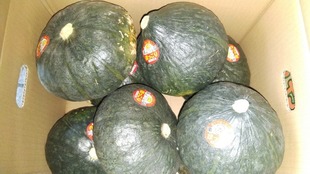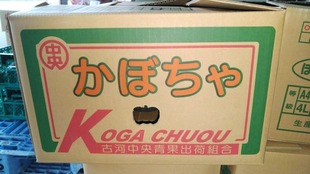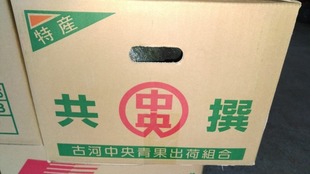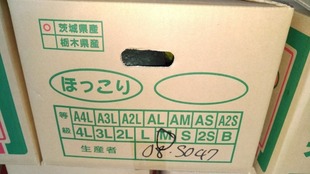【Product name】
Hokkori
【Type】
Cucurbita maxima Duchesne ex Lam.
【wholesale area】
Inamiya, Koga City, Ibaraki Prefecture (Koga Central Fruits and Vegetables Shipping Association)
【Origin of name】
Because it's sweet, unwinded and delicious.
【Major features】
On October 25, 2022, Koga City, Ibaraki Prefecture, the National Kominka Reconstruction Association (Uchisaiwai Town, Chiyoda Ward, Tokyo), and the Koga Branch of the National Empty House Advisor Council signed the nation's first "Agreement on Vacant Houses, etc." has been concluded. Through cooperation and cooperation, the number of vacant houses, including old folk houses, will be reduced, proper management and utilization will be pursued, and the local living environment will be conserved and revitalized. It seems that the main items of cooperation and cooperation include sharing information on vacant houses, controlling the occurrence and utilization of vacant houses, giving advice on the conservation and restoration of vacant houses, and promoting regional revitalization and immigration and settlement using vacant houses. On March 16, 1955, the four villages of Okago, Katori, Katsushika, and Sakurai merged to form Sowa Village. On January 1st, the town organization was implemented and it became Sowa Town. "Sowa" is one of the Zuishochi names. It seems that So is a new place name with the wish of Japanese harmony from the old name of the country "Shimousa". As for the same "auspicious sign name(瑞祥名: 吉兆)", there are now former Sanwa Town in the eastern part of Koga city, and neighboring municipalities such as Yachiyo Town, former Akeno Town, former Kyowa Town, and former Chiyoda Village. It seems that there are various theories about Tsukubamirai City, which is also my countryside. The original Okago village was established in April 1889 by merging the villages of Kami-Ono, Inamiya, Kozutsumi, and Sekido. The new village name seems to come from the fact that Kami-Ono, "Inamiya", and Sekido have been called 'Okago' since ancient times. It is known that during the Edo period, among the villages of the former Koga domain, the area east of Koga Castle was called 'Okago'. List of agricultural products certified by Koga City at the beginning of September 2021. Ayahomaphe Carrot (designated as a fruit and vegetable brand in Ibaraki Prefecture): Made by taking advantage of the characteristics of red clay, it has a sweeter taste than ordinary carrots, and you can enjoy the taste of fruit even if you eat it as it is. Bitter melon (designated as a fruit and vegetable brand production area in Ibaraki Prefecture): Erabu bitter melon (leaves are middle leaves and dark green. The grass is vigorous and long-lasting, and the yield is high. The fruit is cut short, the surface of the squid is rounded and there is little pain in shipping. The fruit length is around 30 cm, and the fruit weight is around 300 g. The diameter is 3.5 to 4 cm for the shoulder, 5.5 cm to 6 cm for the body, 4 to 4.5 cm for the bottom, and the fruit weight is around 300 g. It seems that it is less disturbed and has an excellent rate of excellence.) ”, And it seems that it is trying to produce and ship high-quality bitter melon with good meat and taste. Nickname is "Bitter melon". Sunny lettuce (designated as a fruit and vegetable brand production area in Ibaraki Prefecture): Sunny lettuce (non-heading) in the Sowa area is cultivated actively among the lettuce production areas in the prefecture, and most of it is cultivated in the open field and has received high praise from the market. Roses: With the introduction of rock wool cultivation (hydroponic cultivation), we ship all year round, and we produce high-quality roses with a wide variety of varieties. The annual production is about 1.2 million Roterose, and 40 to 50 varieties are lovingly produced. Pumpkin: The history of pumpkins in the Sowa area is 100 years old. "Miyako Pumpkin", which has a strong sweetness and a warm feeling, is like a sweet and has a special taste that cannot be tasted anywhere else. Ground cherries: Approximately 120,000 pots are produced annually by horticultural farmers in the city. In addition, it seems to occupy about 80% of "Asakusa ground cherries city" which is famous for summer tradition. Chinese cabbage: It is grown as a standard winter vegetable. Among them, "Marbled Chinese cabbage" made in the Isobe area seems to have a higher sugar content than ordinary Chinese cabbage because it stores nutrients firmly by frosting it to the last minute. “Koga City, Ibaraki Prefecture” : It is located in the center of the Kanto Plain, at the western end of the prefecture. Saitama on the west side, Tochigi on the north side, Yuki City on the east side, Yachiyo Town. The south side is in contact with Goka, Sakai, and Bando. The terrain is flat over almost the entire area, and the climate is generally warm.The climate is also generally warm: In natural conditions blessed as a place of living and production. Area 123.58 km2 : Geographical conditions-Also, the distance to Tokyo, Saitama City and Utsunomiya City is 50-60 km.Including JR Utsunomiya Line, the transportation network of Japan National Route 4 and New Japan National Route 4 etc. has been improved. In addition, exchanges with Saitama New Urban Center, Oyama, and Utsunomiya are active. In recent years, population, housing, and industrialization have been concentrated. “古河”は, 古く“許我"と表記. The scene of that time is described in the Manyoshu.It was already crowded as a ferry port for the Watarasegawa River from the Nara Period. ‘万葉集 / 巻十四, 東歌’ - 逢(あ)はずして 行かば惜しけむ 真久良我 (まくらが) の 許我 (こが) 漕ぐ船に 君も逢はぬかも; お会いしないままで 出かけてはとても残念だよ. 真久良我の許我を漕ぐ舟の上の貴方にお会いできたらいいのにな(3558), 真久良我の 許我の渡(わたり)の 韓楫; 可良加治 (舵; からかぢ) の 音高 (おとだか) しもな 寝(ね)なへ児ゆゑ(ヱ)に; 真久良我の 許我の渡しの韓楫(梶)の音が高いように 噂が高く立ったな. 未だ共寝をした娘ではないのに(3555). Koga Village, Expression of one's feelings-It shows that it is a land of rich culture centered on the river.The army of calligraphers is a calligrapher-故大久保翠洞(Suido Okubo-Mainichi (literally, everyday), Founder of the “Engraving” department. 1906-1997) . “Tonegawa River monument” - まくらがの 許我の渡りのからかじの音高しもな寝なへ児ゆえに; まくらがの許我の渡し場に響く韓梶の音のように噂が高い. 一緒に添寝もしない子なのに, 逢はずして行かば惜しけむまくらがの許我こぐ船に君も逢はぬかも; 逢わずに行くのは残念だよ. まくらがの許我を漕ぐ舟であなたにひょっこり逢えないものか. The other monument stands on the Watarase sword beside the Suzume(雀: 鎮め)Shrine(宮前町). The army of the book is a seal carving-故生井子華(Shika Ikui; 1904-89) . Kawatodai Remains(牧野地): There was one of the largest steel making shops in eastern Japan from the beginning of the 9th century to the 10th century; 古河市教育委員会 2012 “川戸台遺跡" 古河市埋蔵文化財調査報告書10, まくらがの里遊歩道建設に伴う牧野地地区埋蔵文化財調査報告書, 種別; 製鉄, 縄文時代, 縄文土器, 土製品, 石器, A large amount of iron-related relics have been excavated. In particular, the amount of excavated mold is 565.981 kg. 獣脚付き鍋や, 把手付き片口鍋等を製作. In addition, letters are engraved on the mold, and when it is inverted, “弥勒”の「勒」, A board-shaped mold that can be read as is excavated. 種別; 製塩, 古墳地代, 竪穴2, 土師器, 円筒埴輪, 石器, 製鉄, 平安時代, 炉4, 工房1, 炭窯1, 粘土採掘坑2, 排滓場4, 柱穴1, 溝4, 路壁, 羽口, 小型専用坩堝, 鋳型, 鉄製品, 土師器, 須恵器, 灰釉陶器, 瓦, かわらけ(土師質土器), 内耳鍋, 製鉄, 中世 (細分不明) 時代, 溝4, 中世以降. Eguchi-Nagaoki kiln remains: A semi-basement type flat kiln was also discovered in the latter half of the 9th century.毛野考古学研究所他 2011 “江口長沖窯跡” 古河市埋蔵文化財調査報告書5 , 筑西幹線道路整備に伴う江口地区内埋蔵文化財調査報告書. It seems that it was also a production base for iron and ceramics. The home of Koga from the late Muromachi period to the Warring States period. 5th Kamakura kubo (Governor-general) - Shigeuji Ashikaga(Founder)has moved from Kamakura to Koga. Assassination of Kanto Kanrei, Noritada Uesugi, Kyotoku Inciden; After that, it was handed over to Masauji, Takamoto, Haruuji, and Yoshiuji for about 130 years. Castle town of Koga Castle in the Edo period: Koga inn(通町; 横町, 1,2丁目, 台町, 原町. 脇町 / 街道東側, 鍛冶町, 新町, 八幡町. 西側; 石町, 江戸町, 大工町. 川沿い; 悪戸新田, 船渡町. 枝町; 紺屋町, 天神町, 田町, 青物町, 七軒町, 肴町, 元肴町, 四谷 / 嵯峨.屋敷町; 厩町, 白壁町, 仲之町, 鳥見町, 杉並町, 代官町, 三神町, 片町, 六軒町 / 四軒町), a post town on the Nikko Kaido, flourished. The Koga domain spans Shimousa, Shimotsuke, and Musashi provinces. The city area was also incorporated into Ibaraki Prefecture via Shimousa and Chiba prefectures. Former Hitachi country, formed mainly by Mito Kaido(The roads which ran from Edo to Sendai along the Pacific coast were called “Rikuzenhama Road,” and among them the one which ran to Mito City, where one of three privileged branches of Tokugawa family was located, was occasionally called): Positioned as a sidestream in the history of Ibaraki Prefecture since modern times. Inamiya District : 旧遺跡番号030, 東小路遺跡, 稲宮字東小路 外, 古墳, 奈良 / 平安, 中世, 近世, 散布地, 土師器, 陶器, 磁器, 鉄滓, フイゴ(鞴). 「総和町埋蔵文化祭包蔵地基本調査報告書」総和町教育委員会1978年「茨城県総和町埋蔵文化財分布調査概報4」総和町教育委員会2001年, 旧遺跡番号031, 行屋西遺跡, 稲宮字中ノ小路西 外, 旧石器, 縄文, 弥生, 古墳, 奈良 / 平安, 中世, 近世, 集落跡, 竪穴住居跡(古墳~平安時代), 掘立柱建物跡(奈良 / 平安時代), 土坑. 神辺遺跡と統合. 2000年発掘調査. 石器(石鏃), 縄文土器, 弥生土器, 土師器, 須恵器, 陶器, 磁器, 鉄製品, 「総和町史 資料編 原始 / 古代 / 中世」総和町町史編さん委員会2002年(114ページ).「総和町埋蔵文化祭包蔵地基本調査報告書」総和町教育委員会1978年「茨城県総和町採集の石器」『法政考古学 第25集』諸星良一氏1999年「茨城県総和町埋蔵文化財分布調査概報4」総和町教育委員会2001年. 旧遺跡番号032, 北久保遺跡, 稲宮字北久保, 縄文, 古墳, 奈良 / 平安, 中世, 近世, 散布地, 縄文土器, 土師器, 須恵器, 陶器, 磁器. 「総和町埋蔵文化祭包蔵地基本調査報告書」総和町教育委員会1978年「茨城県総和町埋蔵文化財分布調査概報4」総和町教育委員会2001年. 旧遺跡番号033, 高草遺跡, 稲宮字高草, 南小路 外, 縄文, 古墳, 奈良 / 平安, 包蔵地, 縄文土器, 土師器, 須恵器, 陶磁器. 「総和町埋蔵文化祭包蔵地基本調査報告書」総和町教育委員会1978年「茨城県総和町埋蔵文化財分布調査概報4」総和町教育委員会2001年. 旧遺跡番号034, 高草前古墳群, 稲宮字高草前, 古墳, 古墳群. 「総和町史 資料編 原始 / 古代 / 中世」総和町町史編さん委員会 2002年(261ページ), 「総和町埋蔵文化祭包蔵地基本調査報告書」総和町教育委員会1978年「茨城県総和町埋蔵文化財分布調査概報4」総和町教育委員会2001年. Nirei / Nire(仁礼; 仁連)is a place name from the Warring States period. 第4代古河公方 / 足利晴氏安堵状写: 若林 / 仁礼両郷. During the Warring States period, it was a royal palace of Koga Kubo. Chigyo Enforcement Letter on September 20, 1590-From Hideyoshi to Harushige Yamakawa(Originally a retainer of the Yuki family-山川綾戸城; 現: 結城市山川新宿): 幸島郷之内, 二十五貫, 仁連. Nirei Town, It was allowed as a post station on the Nikko Higashi Kaido (Nikko Sekiyado Takodo): 江戸時代; 1648年(慶安元年)11月6日-猿島郡郷土大観, 1927: 往昔領主堀江侯なるもの 若林に小城を設けて居住せし... By the way, Nirei also has the upper and lower towns that are often seen in post stations. Kami Town is located on the north side and Shitamachi is located on the south side. In order from the south-Uemachi, Nakamachi (Nakamachi), Shitamachi in order. Why are Nirei and Morokawa in the opposite order? There's room for improvement. Forgive me because I still lack research. 鷹見泉石(古河藩家老) 関係資料(H16, 国指定文化財; 歴史博物館(中央町)) 文書 / 記録類686点, 絵図 / 地図類768点, 書籍類466点, 書状類912点, 絵画 / 器物類321. Quoting Kunio Yanagita(1875-1962)'s "Research of Name of Places, 1936", Koga is not an undeveloped land at the intersection of Watatsu, so it is unnatural to originate from empty space, and "Kaga" means lawn or grassland. There is also a hypothesis that it is a corruption of. Furthermore, considering the characteristics of the topography of ancient Furukawa, it was a narrow land surrounded by water, so this hypothesis is also lacking in conclusive evidence. Ancient Koga faced Oku-Tokyo Bay, which was formed by the sea spreading to the inland area, and Tatezaki, which was a breakwater on the south side (Tatezaki at that time was a tongue-shaped plateau extending from Hase toward the inner citadel of Koga Castle). The north side is a good natural harbor with coves in the direction of Daikanmachi and Tamachi. During strong winds from the southeast due to typhoons in autumn and strong winds from the west in winter, boats are anchored and temporary lodgings waiting for the wind to stop. I thought it was. If that's the case, could it be a stage for a short-lived love story, just as it was sung in the Manyoshu? Western pumpkin (originating in the southeastern plateau): It seems that it was introduced around 1863. Land development bureau has introduced many varieties from the United States, including “Turban Squash”, “Delicious Squash (castella)”, and “Happered Squash (masakari).” Due to its lack of heat resistance, it was first cultivated and eaten mainly in cool summer areas such as Hokkaido. It began to be cultivated in Japan (Hokkaido?) In the early Meiji era, and two strains, Happard and Delicious, were selected and mainly cultivated. I hear that it was the origin of today's Western pumpkins. Since the beginning of the Showa period, the cultivation area has increased, and the “Fragrant green-skinned chestnuts (cultivated by Watanabe Seed Co., Ltd. in 1935)” that were bred in the early stages were called “Tokyo pumpkins”. In 1964, sticky “Ebisu Squash” (Takii Seed Co., Ltd.) appeared, and in 1970, “Miyako Squash” (cultivated by the Japan Horticultural Production Research Institute) also appeared. “Hokkori Squash”, It is best to cultivate two pups, but it is also suitable for free-ranging cultivation, and the grass vigor is stronger than “Ebisu”, but the amount of fertilizer applied is basically the same as that of “Ebisu Squash”. However, in fields where stress is extremely strong, it seems desirable to reduce the amount of fertilizer applied by about 20%. The edible period is about 35 days after mating, but it is fully ripe in 45 to 50 days and the powder quality is the highest, so it is desirable to have a fully ripe harvest for high quality shipment. Since the fruit with low-node fruit set will not grow sufficiently in the future, it is advisable to remove the fruit with fruit set at the root of the plant as soon as possible and try to set fruit at the appropriate node position (around 10 nodes or more). In direct sowing cultivation, the soil temperature (15-18 ° C) and the germination vigor are delayed by about 2 days (the germination rate is the same) compared to “Ebisu Squash”, so it is recommended to sow after ensuring the soil temperature as much as possible. Since the powder quality is high, the quality of the fruit deteriorates slowly after harvesting, and the size of the fruit becomes large, about the size of “Ebisu Squash”, and the yield increases. In addition, the pericarp is extremely dark green with flicker spots, and the fruit shape seems to be finished with a high instep and voluminous appearance. According to Takii & Co., Ltd., Hokkori 133 Squash has a dense meat quality and is fluffy like chestnuts, and is particularly sweet and delicious. Since the powder quality is high, it has a long life after harvesting and the quality deterioration seems to be slow. The size of the fruit is a large ball about the size of "Ebisu squash", and the yield increases. The pericarp is extremely dark green with fliers. The fruit shape seems to be finished with a high instep and voluminous appearance. In the case of ripe harvest, the flesh color is dark yellow and it looks good and is suitable for selling. The female flower is particularly good, and it grows well from the low node, and the fruit set is good. The grass is slightly larger and thicker than the "Ebisu Squash". Tsuruta has good mochi, so high-quality fruits are highly expected.
According to Takii Seed Co., Ltd., Hokkori 133 Squash has a dense flesh, a chestnut-like texture, and a particularly sweet taste. Because of its high flour quality, it lasts for a long time after harvesting, and it seems that quality deterioration is slow. The size of the fruit is a large ball, about the size of "Ebisu Squash", and the yield is increased. The pericarp is extremely dark green with mottled spots. The fruit has a high instep and a voluminous appearance. In the case of fully ripened harvest, the flesh color is dark yellow and looks good and seems to be suitable for selling by the piece. The female flower is particularly good, and it grows well from the low node, and the fruit setting is good. The grass shape is a little stronger with large leaves and thick vines compared to "Ebisu Squash". It is said that high-quality fruit is expected because the vine has good longevity.
The history of pumpkin cultivation in the Sowa area of the city goes back more than 100 years. It seems that he has been researching soil improvement independently for many years, and has been making organic farming, chicken manure compost, and ripe leaf mulch. The Sanwa area is also famous for its fertile soil and inland climate, where the temperature difference between day and night is large, making it suitable for pumpkin cultivation. For those in the know, "Miyako Pumpkin" production is also thriving. It is characterized by a dark green skin with light green stripes, and is highly popular for its strong sweetness, fluffy and smooth texture, and deep flavor.
In Koga City, building a new local production for local consumption model. It's taking root little by little. In order to make full use of the favorable local conditions within 60 km from the city center in order to promote agriculture, it seems necessary to accurately grasp the needs of the city residents who are the main consumers. What urban residents want is something that cannot be obtained or is difficult to obtain in the city center, and one of them is "safe and secure" food. Awareness of food safety. On the rise, getting food by face-to-face with producers is the most reliable and consumer-oriented way of all. In addition, we have been using the local conditions of being able to come and go in one hour one way as an advantage of a production base, but we have changed the way of thinking that it is also an advantage in terms of attracting customers, and we will promote the creation of an environment where consumers can visit the production area and production site themselves. By doing so, we have built a new local food production and consumption model that “produces in the region and consumes (purchases) in the region”. For that reason, it is necessary to create new local resources as an opportunity to visit a familiar production base that can be visited within 60 km from the city center in one hour. The kind of Japanese rice wine that remains in the bottle (the grounds are deposited at the bottom of the bottle in two layers) seems to be gaining popularity.
Hokkori 133 Pumpkin cultivation is best done with two vines, the position of the first fruit should be after the 10th node, and the female flower at the lower node should be removed as soon as possible. In addition, although the standard amount of fertilizer is used as a standard, it seems to be more effective to reduce the amount of base fertilizer by about 20% in fertile soil (where countless molds and bacteria grow and the nutrients are well-balanced). It seems to be good to ship after sufficient curing as it has a high degree of flour. In the case of direct sowing, ensure sufficient soil temperature (20°C or higher) before sowing.







0 件のコメント:
コメントを投稿